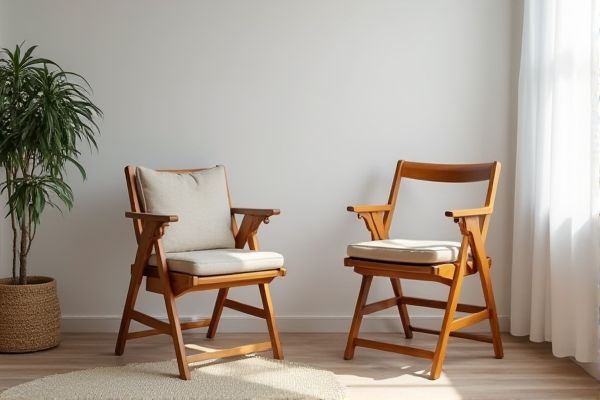
Folding chairs offer easy portability and compact storage by collapsing flat, making them ideal for temporary seating needs, while stacking chairs are designed to be conveniently piled on top of each other to save space in environments like conference rooms and cafeterias. Explore the rest of the article to discover which chair best suits Your specific requirements and lifestyle.
Table of Comparison
| Feature | Folding Chair | Stacking Chair |
|---|---|---|
| Design | Hinged folding mechanism; folds flat | Rigid frame; designed for vertical stacking |
| Storage | Compact, saves space by folding | Efficient vertical stacking, saves floor space |
| Portability | Highly portable and easy to carry | Less portable; designed for stationary stacking |
| Durability | Variable, depends on hinge quality | Generally more durable and robust |
| Weight | Usually lightweight | Can be heavier due to solid construction |
| Use Case | Temporary seating, events, outdoor use | Permanent or semi-permanent setups, conference rooms |
| Setup Time | Quick to unfold and use | Requires unstacking; usually easy to set up |
| Price Range | Generally affordable | Varies; often mid to high depending on material |
Introduction to Folding Chairs and Stacking Chairs
Folding chairs and stacking chairs offer versatile seating solutions ideal for various spaces and events. Folding chairs feature a hinged design that allows them to collapse flat for easy storage and portability, while stacking chairs are designed to be piled vertically, saving floor space without the need for folding. Your choice depends on how frequently you need to move or store the chairs and the convenience you prioritize in your seating arrangement.
Design and Construction Differences
Folding chairs feature a hinged frame that allows the seat and legs to collapse flat for compact storage, typically constructed with lightweight metal or plastic for portability. Stacking chairs are designed with a rigid frame that enables multiple chairs to be neatly stacked vertically, often using durable materials like steel or molded wood to maintain stability when piled. The key design difference lies in folding chairs' emphasis on space-saving through collapsibility, while stacking chairs prioritize efficient storage by nesting multiple units securely.
Space-Saving Benefits: Folding vs. Stacking
Folding chairs offer excellent space-saving benefits by collapsing into a flat, compact form that easily fits into closets or under beds, making them ideal for occasional use and small storage areas. Stacking chairs save space by nesting directly on top of one another, which is efficient for storage in bulk and common in event or commercial settings where access and quick setup are priorities. Both types optimize storage, but folding chairs are more versatile for limited spaces, while stacking chairs excel in maximizing vertical storage capacity.
Portability and Ease of Transportation
Folding chairs offer superior portability due to their compact fold-flat design, making them easy to carry and store in small spaces or transport in vehicles. Stacking chairs, while bulkier, allow efficient handling in multiples by nesting securely on top of each other, which is ideal for moving larger quantities at once with minimal effort. Both designs enhance transportation efficiency, but folding chairs excel in individual mobility whereas stacking chairs optimize bulk movement.
Durability and Material Options
Folding chairs are typically made from lightweight materials like aluminum or plastic, prioritizing portability over long-term durability. Stacking chairs often feature sturdier construction using metal frames and reinforced seating surfaces, making them more durable for frequent use in commercial or event settings. Your choice should consider how the chair's material and durability align with the intended environment and frequency of use.
Comfort and Ergonomics Comparison
Folding chairs typically offer basic comfort with minimal padding and limited ergonomic support, making them suitable for short-term seating but less ideal for extended use. Stacking chairs often feature contoured seats and backrests designed to improve posture and provide enhanced lumbar support, increasing overall comfort during prolonged periods. Your choice should consider the intended duration of use, as stacking chairs generally deliver superior ergonomics for long-term seating compared to folding chairs.
Ideal Uses for Folding Chairs
Folding chairs are ideal for temporary seating arrangements such as outdoor events, conferences, and small gatherings due to their portability and easy storage. Their lightweight design allows for quick setup and takedown, making them perfect for spaces with limited room or frequent rearrangements. These chairs are commonly used in venues like community centers, camping sites, and banquet halls where flexibility and convenience are essential.
Best Applications for Stacking Chairs
Stacking chairs are ideal for venues requiring efficient space management and easy storage, such as conference rooms, banquet halls, and educational institutions. Their design allows multiple chairs to be securely stacked, maximizing floor space and simplifying setup and cleanup processes. You benefit from their durability and lightweight construction, making them perfect for frequent use in both indoor and outdoor settings.
Maintenance and Storage Considerations
Folding chairs offer compact storage solutions by collapsing flat, making them ideal for limited spaces and easy transportation. Stacking chairs optimize storage by nesting securely on top of each other, reducing floor space usage in bulk. Both types require regular cleaning and inspection, but folding chairs may need more attention to hinge mechanisms to ensure smooth operation over time.
Choosing the Right Chair: Key Decision Factors
Folding chairs offer portability and quick storage, appealing for temporary seating needs in events or small spaces. Stacking chairs optimize space efficiency by allowing multiple chairs to be securely stacked, ideal for venues requiring high-density seating arrangements. Key decision factors include frequency of use, storage space, and ease of transport to determine the most functional and practical chair type.
 homyna.com
homyna.com